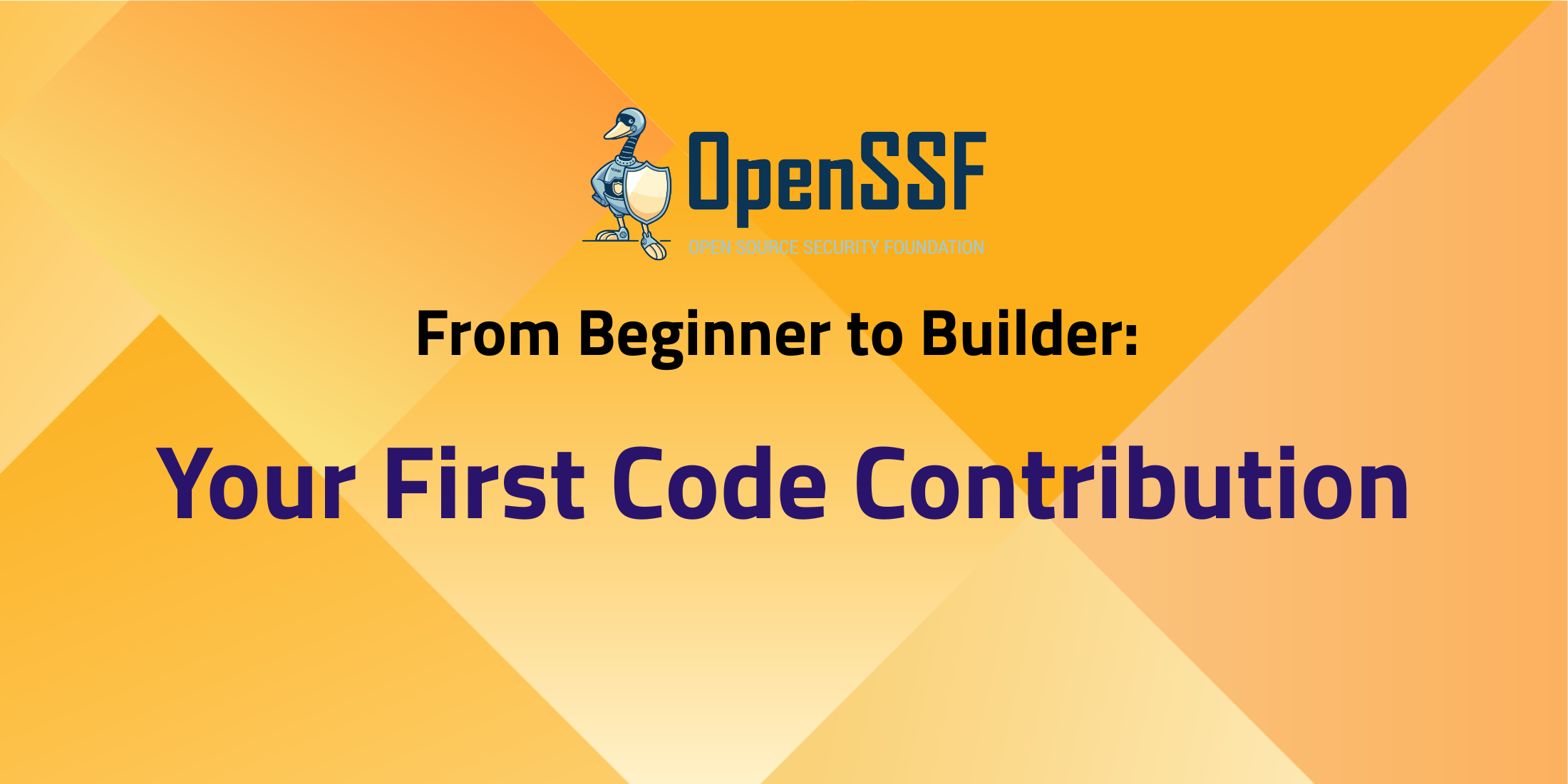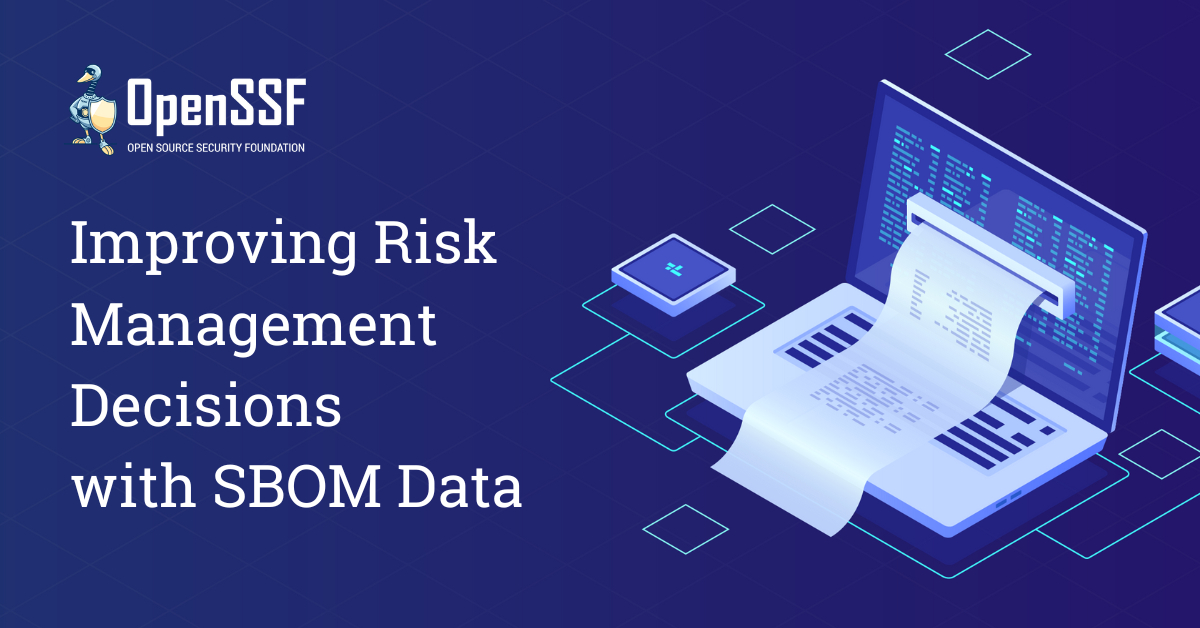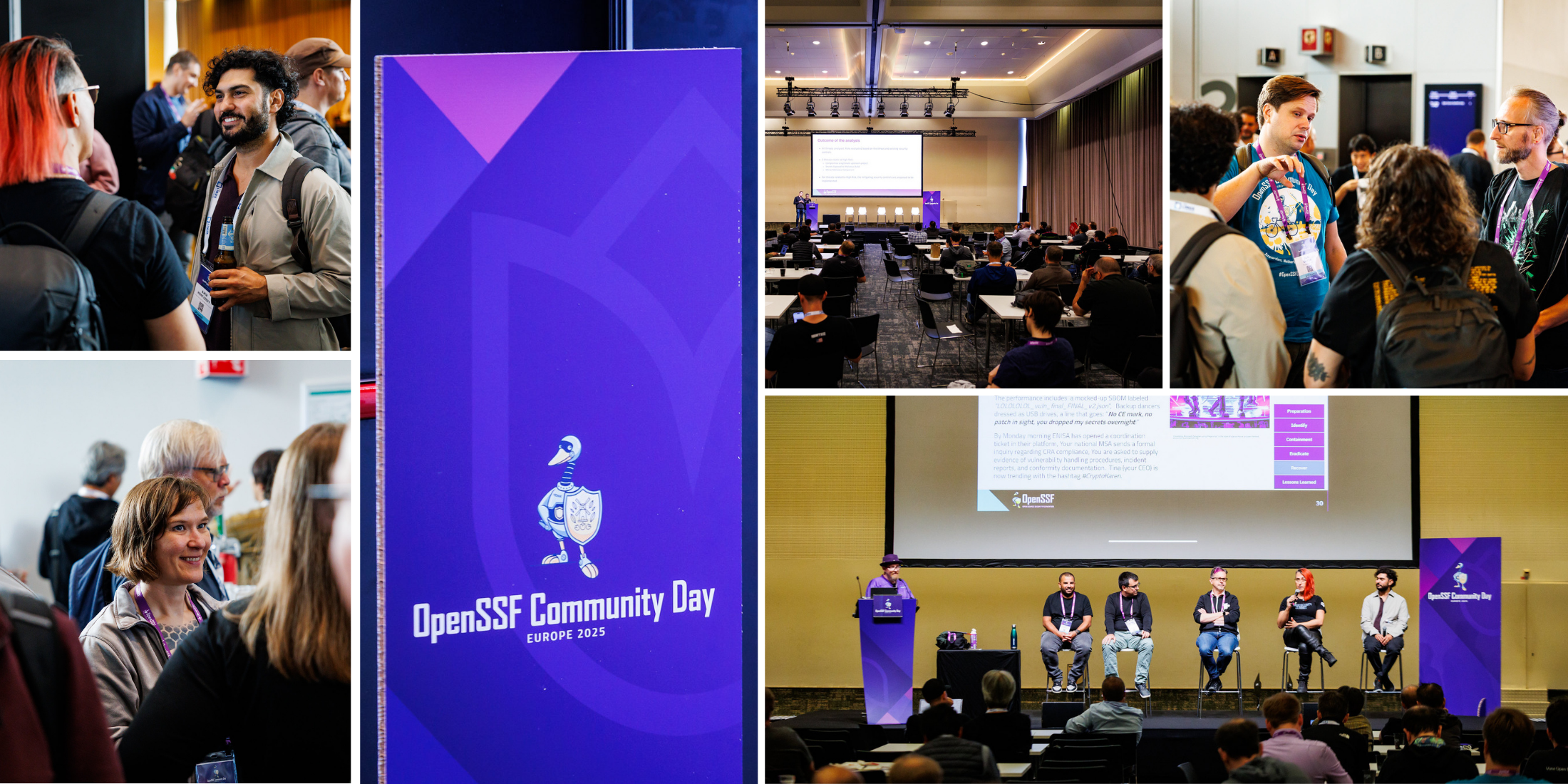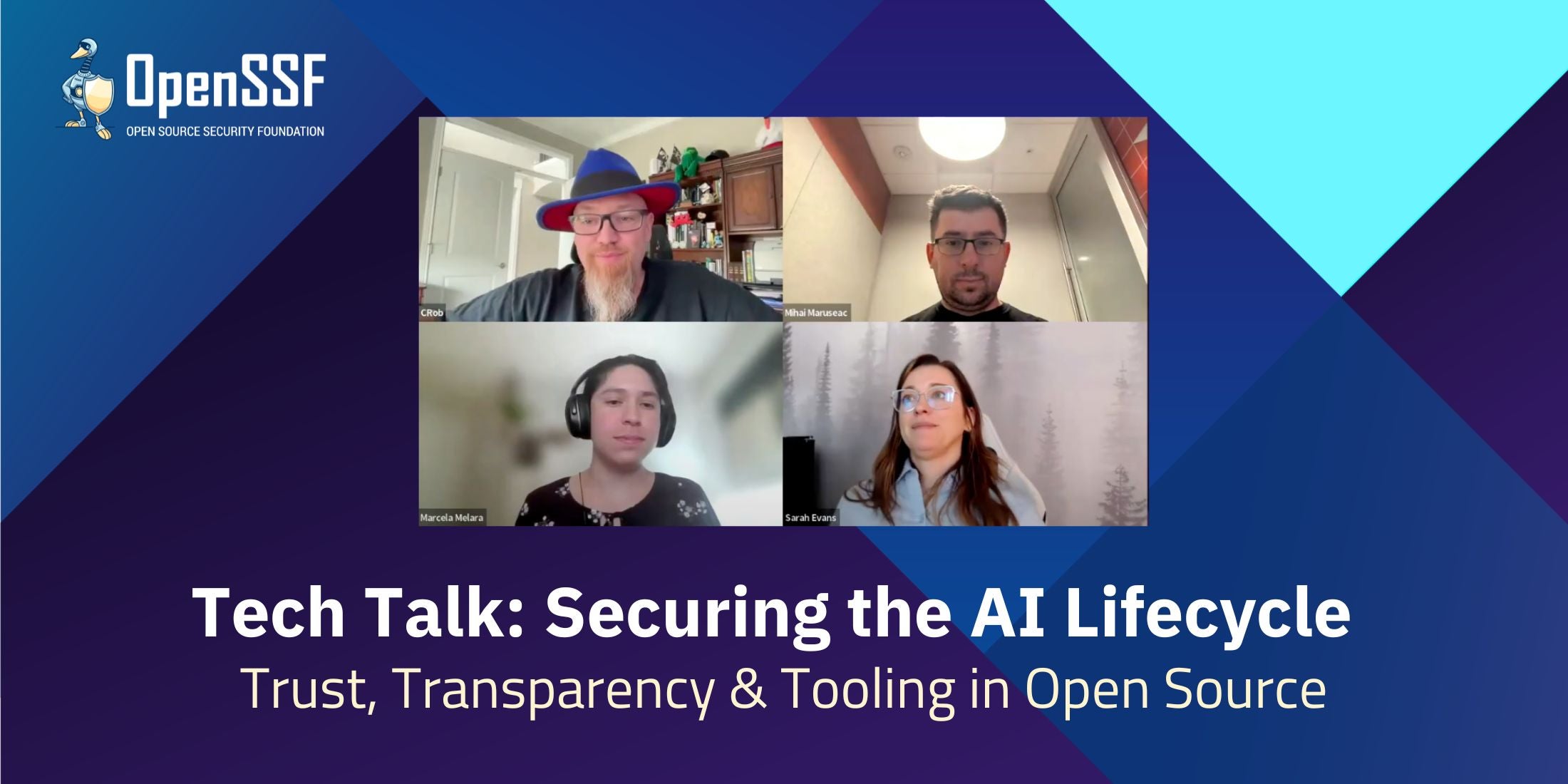


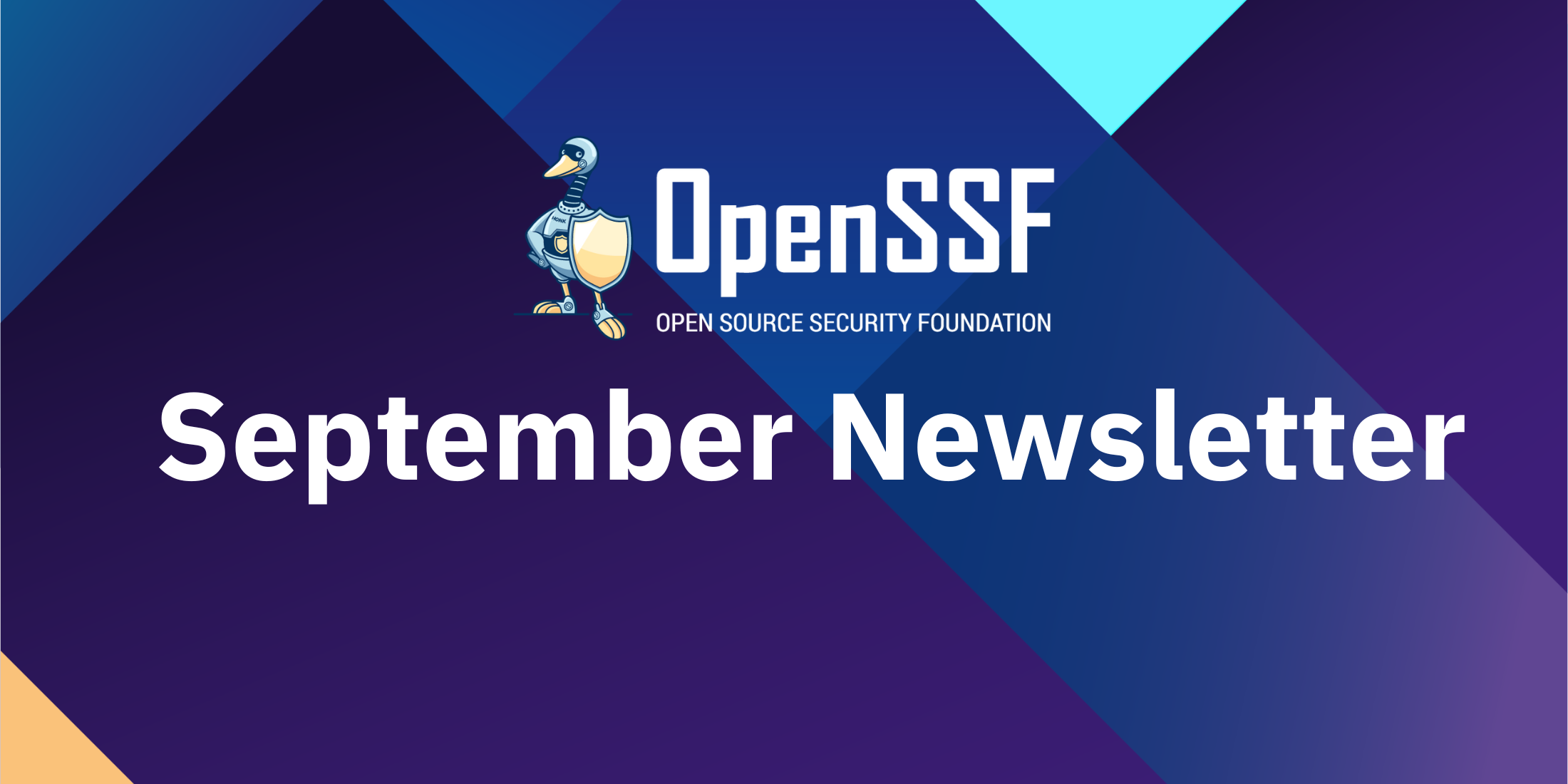
Welcome to the September 2025 edition of the OpenSSF Newsletter! Here’s a roundup of the latest developments, key events, and upcoming opportunities in the Open Source Security community.
🎉 Big week in Amsterdam: Recap of OpenSSF at OSSummit + OpenSSF Community Day Europe.
🥚 Golden Egg Awards shine on five amazing community leaders.
✨ Fresh resources: AI Code Assistant tips and SBOM whitepaper.
🤝 Trustify + GUAC = stronger supply chain security.
🌍 OpenSSF Community Day India: 230+ open source enthusiasts packed the room.
🎙 New podcasts: AI/ML security + post-quantum race.
🎓 Free courses to level up your security skills.
📅 Mark your calendar and join us for Community Events.
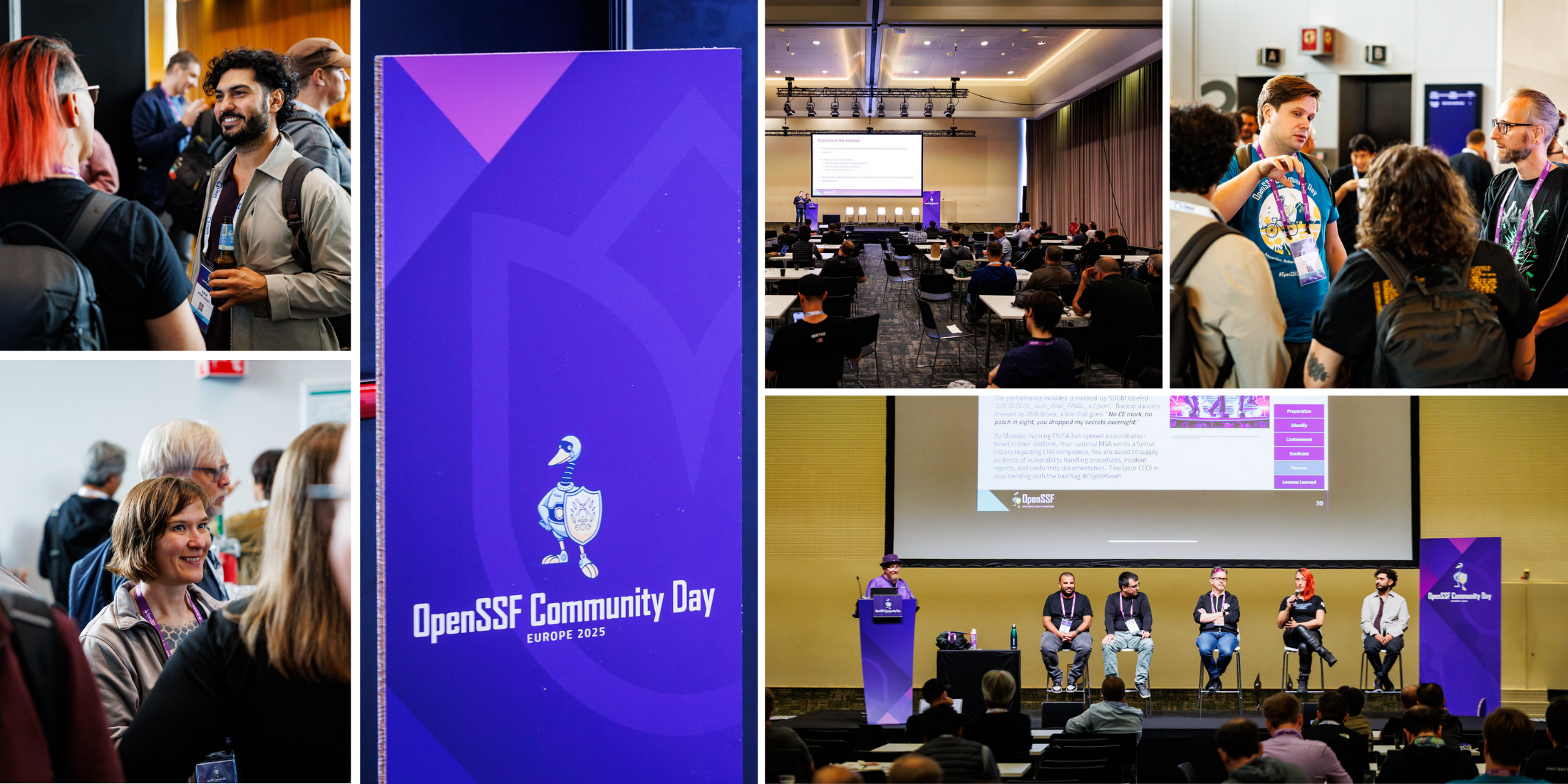 From August 25–28, 2025, the Linux Foundation hosted Open Source Summit Europe and OpenSSF Community Day Europe in Amsterdam, bringing together developers, maintainers, researchers, and policymakers to strengthen software supply chain security and align on global regulations like the EU Cyber Resilience Act (CRA). The week included strong engagement at the OpenSSF booth and sessions on compliance, transparency, proactive security, SBOM accuracy, and CRA readiness.
From August 25–28, 2025, the Linux Foundation hosted Open Source Summit Europe and OpenSSF Community Day Europe in Amsterdam, bringing together developers, maintainers, researchers, and policymakers to strengthen software supply chain security and align on global regulations like the EU Cyber Resilience Act (CRA). The week included strong engagement at the OpenSSF booth and sessions on compliance, transparency, proactive security, SBOM accuracy, and CRA readiness.
OpenSSF Community Day Europe celebrated milestones in AI security, public sector engagement, and the launch of Model Signing v1.0, while also honoring five community leaders with the Golden Egg Awards. Attendees explored topics ranging from GUAC+Trustify integration and post-quantum readiness to securing GitHub Actions, with an interactive Tabletop Exercise simulating a real-world incident response.
These gatherings highlighted the community’s progress and ongoing commitment to strengthening open source security. Read more.
At OpenSSF Community Day Europe, the Open Source Security Foundation honored this year’s Golden Egg Award recipients. Congratulations to Ben Cotton (Kusari), Kairo de Araujo (Eclipse Foundation), Katherine Druckman (Independent), Eddie Knight (Sonatype), and Georg Kunz (Ericsson) for their inspiring contributions.
With exceptional community engagement across continents and strategic efforts to secure the AI/ML pipeline, OpenSSF continues to build trust in open source at every level.
Read the full press release to explore the achievements, inspiring voices, and what’s next for global open source security.
Here you will find a snapshot of what’s new on the OpenSSF blog. For more stories, ideas, and updates, visit the blog section on our website.
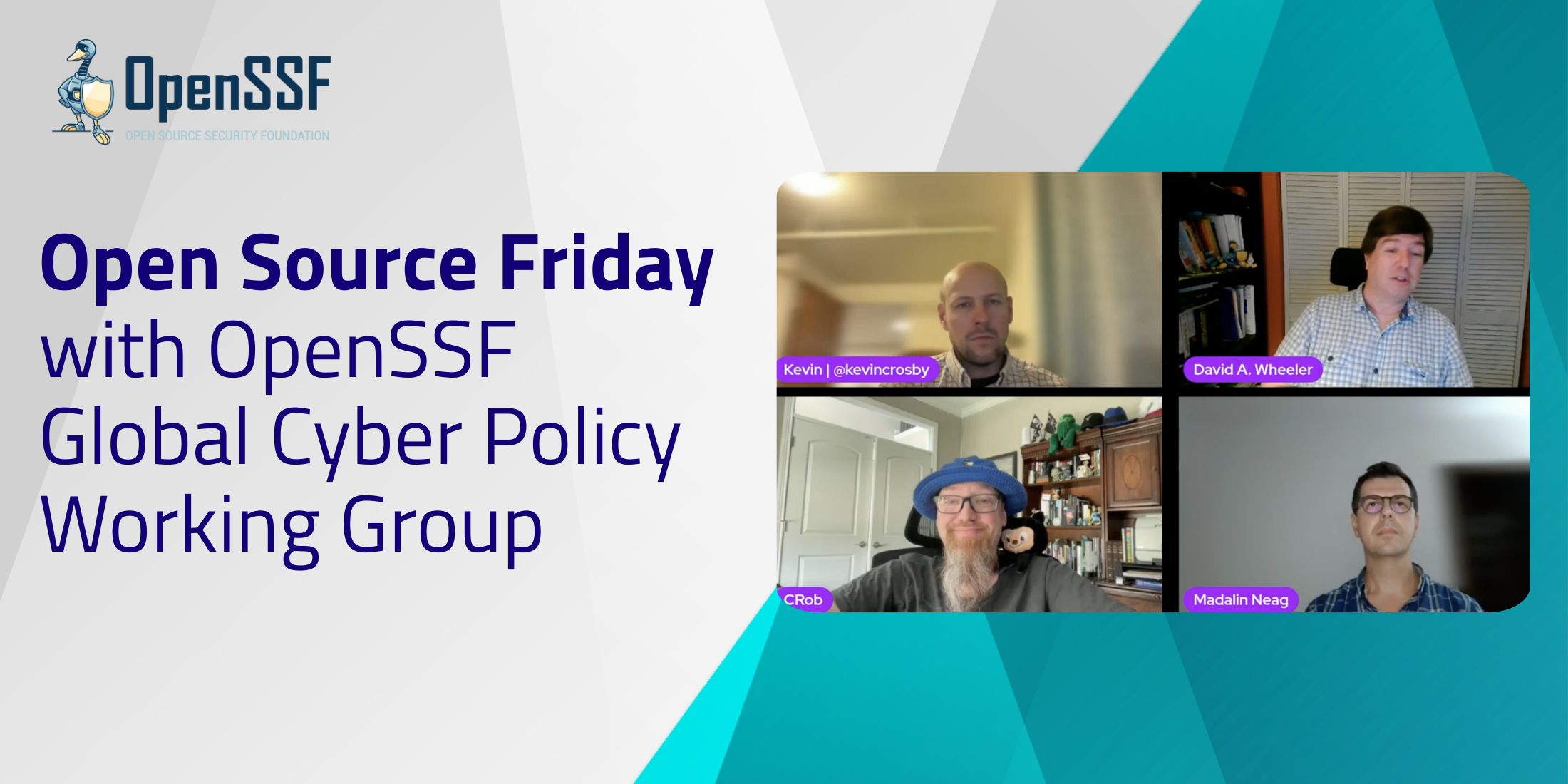 On August 15, 2025, GitHub’s Open Source Friday series spotlighted the OpenSSF Global Cyber Policy Working Group (WG) and the OSPS Baseline in a live session hosted by Kevin Crosby, GitHub. The panel featured OpenSSF’s Madalin Neag (EU Policy Advisor), Christopher Robinson (CRob) (Chief Security Architect) and David A. Wheeler (Director of Open Source Supply Chain Security) who discussed how the Working Group helps developers, maintainers, and policymakers navigate global cybersecurity regulations like the EU Cyber Resilience Act (CRA).
On August 15, 2025, GitHub’s Open Source Friday series spotlighted the OpenSSF Global Cyber Policy Working Group (WG) and the OSPS Baseline in a live session hosted by Kevin Crosby, GitHub. The panel featured OpenSSF’s Madalin Neag (EU Policy Advisor), Christopher Robinson (CRob) (Chief Security Architect) and David A. Wheeler (Director of Open Source Supply Chain Security) who discussed how the Working Group helps developers, maintainers, and policymakers navigate global cybersecurity regulations like the EU Cyber Resilience Act (CRA).
The conversation highlighted why the WG was created, how global policies affect open source, and the resources available to the community, including free training courses, the CRA Brief Guide, and the Security Baseline Framework. Panelists emphasized challenges such as awareness gaps, fragmented policies, and closed standards, while underscoring opportunities for collaboration, education, and open tooling.
As the CRA shapes global standards, the Working Group continues to track regulations, engage policymakers, and provide practical support to ensure the open source community is prepared for evolving cybersecurity requirements. Learn more and watch the recording.
SBOMs are becoming part of everyday software practice, but many teams still ask the same question: how do we turn SBOM data into decisions we can trust?
Our new whitepaper, “Improving Risk Management Decisions with SBOM Data,” answers that by tying SBOM information to concrete risk-management outcomes across engineering, security, legal, and operations. It shows how to align SBOM work with real business motivations like resiliency, release confidence, and compliance. It also describes what “decision-ready” SBOMs look like, and how to judge data quality. To learn more, download the Whitepaper.
 GUAC and Trustify are combining under the GUAC umbrella to tackle the challenges of consuming, processing, and utilizing supply chain security metadata at scale. With Red Hat’s contribution of Trustify, the unified community will serve as the central hub within OpenSSF for building and using supply chain knowledge graphs, defining standards, developing shared infrastructure, and fostering collaboration. Read more.
GUAC and Trustify are combining under the GUAC umbrella to tackle the challenges of consuming, processing, and utilizing supply chain security metadata at scale. With Red Hat’s contribution of Trustify, the unified community will serve as the central hub within OpenSSF for building and using supply chain knowledge graphs, defining standards, developing shared infrastructure, and fostering collaboration. Read more.
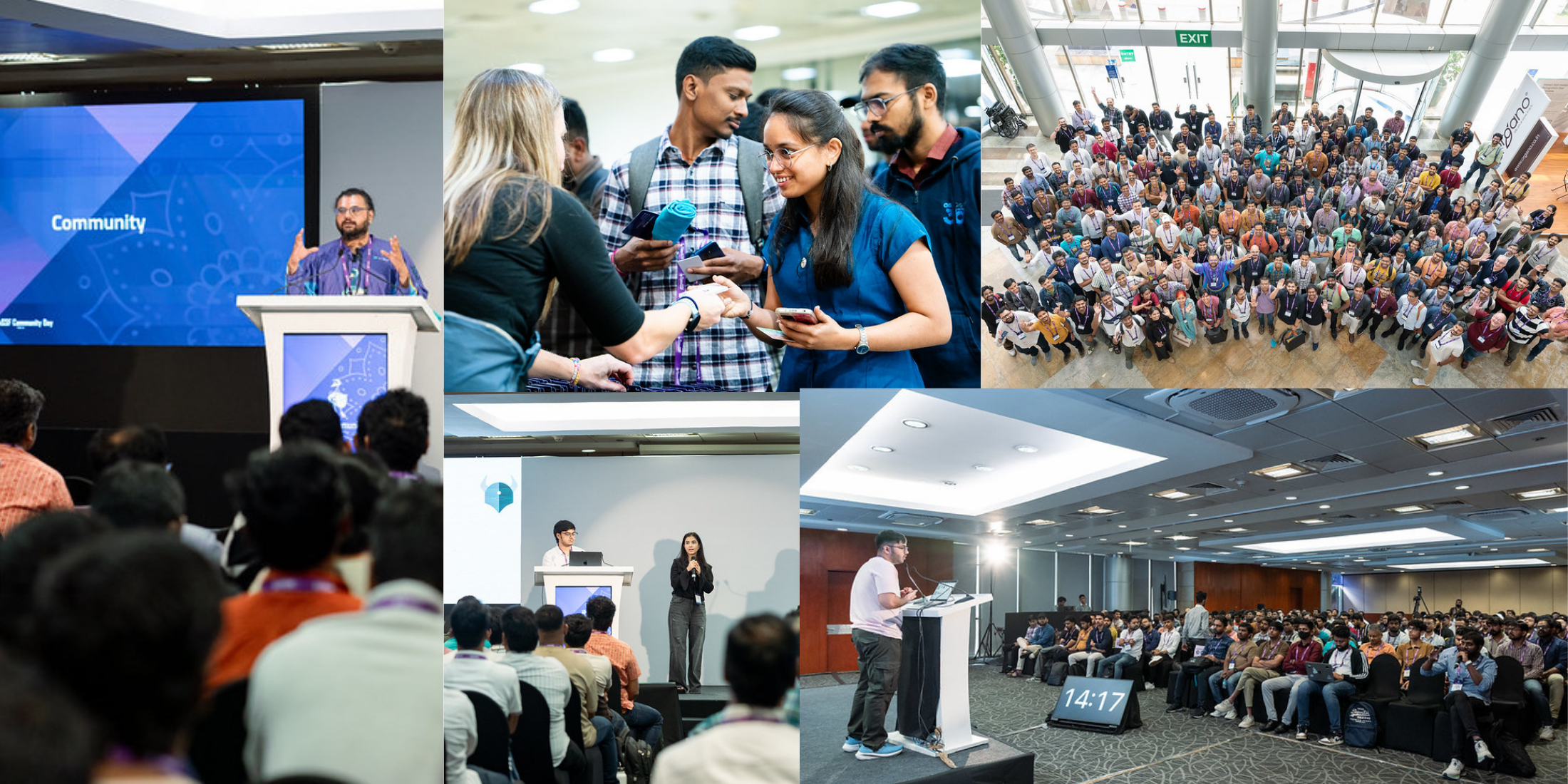 On August 4, 2025, OpenSSF hosted its second Community Day India in Hyderabad, co-located with KubeCon India. With 232 registrants and standing-room-only attendance, the event brought together open source enthusiasts, security experts, engineers, and students for a full day of learning, collaboration, and networking.
On August 4, 2025, OpenSSF hosted its second Community Day India in Hyderabad, co-located with KubeCon India. With 232 registrants and standing-room-only attendance, the event brought together open source enthusiasts, security experts, engineers, and students for a full day of learning, collaboration, and networking.
The event featured opening remarks from Ram Iyengar (OpenSSF Community Engagement Lead, India), followed by technical talks on container runtimes, AI-driven coding risks, post-quantum cryptography, supply chain security, SBOM compliance, and kernel-level enforcement. Sessions also highlighted tools for policy automation, malicious package detection, and vulnerability triage, as well as emerging approaches like chaos engineering and UEFI secure boot.
The event highlighted India’s growing role in global open source development and the importance of engaging local communities to address global security challenges. Read more.
In our recent blog, Avishay Balter, Principal SWE Lead at Microsoft and David A. Wheeler, Director, Open Source Supply Chain Security at OpenSSF introduce the OpenSSF “Security-Focused Guide for AI Code Assistant Instructions.” AI code assistants can speed development but also generate insecure or incorrect results if prompts are poorly written. The guide, created by the OpenSSF Best Practices and AI/ML Working Groups with contributors from Microsoft, Google, and Red Hat, shows how clear and security-focused instructions improve outcomes. It stands as a practical resource for developers today, while OpenSSF also develops a broader course (LFEL1012) on using AI code assistants securely.
This effort marks a step toward ensuring AI helps improve security instead of undermining it. Read more.
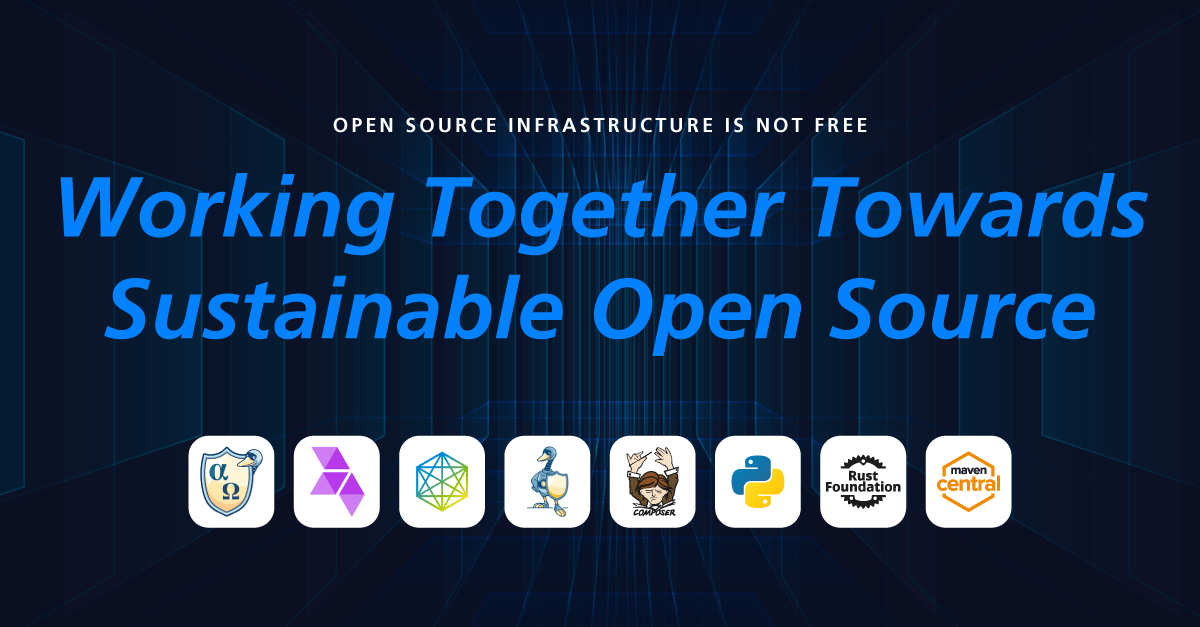 Public package registries and other shared services power modern software at global scale, but most costs are carried by a few stewards while commercial-scale users often contribute little. Our new open letter calls for practical models that align usage with responsibility — through partnerships, tiered access, and value-add options — so these systems remain strong, secure, and open to all.
Public package registries and other shared services power modern software at global scale, but most costs are carried by a few stewards while commercial-scale users often contribute little. Our new open letter calls for practical models that align usage with responsibility — through partnerships, tiered access, and value-add options — so these systems remain strong, secure, and open to all.
Signed by: OpenSSF, Alpha-Omega, Eclipse Foundation (Open VSX), OpenJS Foundation, Packagist (Composer), Python Software Foundation (PyPI), Rust Foundation (crates.io), Sonatype (Maven Central).
#38 – S2E15 Securing AI: A Conversation with Sarah Evans on OpenSSF’s AI/ML Initiatives
In this episode of What’s in the SOSS, Sarah Evans, Distinguished Engineer at Dell Technologies, discusses extending secure software practices to AI. She highlights the AI Model Signing project, the MLSecOps whitepaper with Ericsson, and efforts to identify new personas in AI/ML operations. Tune in to hear how OpenSSF is shaping the future of AI security.
#39 – S2E16 Racing Against Quantum: The Urgent Migration to Post-Quantum Cryptography with KeyFactor’s Crypto Experts
In this episode of What’s in the SOSS, host Yesenia talks with David Hook and Tomas Gustavsson from Keyfactor about the race to post-quantum cryptography. They explain quantum-safe algorithms, the importance of crypto agility, and why sectors like finance and supply chains are leading the way. Tune in to learn the real costs of migration and why organizations must start preparing now before it’s too late.
The Open Source Security Foundation (OpenSSF), together with Linux Foundation Education, provides a selection of free e-learning courses to help the open source community build stronger software security expertise. Learners can earn digital badges by completing offerings such as:
These are just a few of the many courses available for developers, managers, and decision-makers aiming to integrate security throughout the software development lifecycle.
Join us at OpenSSF Community Day in South Korea!
OpenSSF Community Days bring together security and open source experts to drive innovation in software security.
Connect with the OpenSSF Community at these key events:
There are a number of ways for individuals and organizations to participate in OpenSSF. Learn more here.
You’re invited to…
We want to get you the information you most want to see in your inbox. Missed our previous newsletters? Read here!
Have ideas or suggestions for next month’s newsletter about the OpenSSF? Let us know at marketing@openssf.org, and see you next month!
Regards,
The OpenSSF Team
In this episode of What’s in the SOSS, CRob has an inspiring conversation with Kate Stewart, a Linux Foundation veteran who took an unconventional path into open source as a manager rather than a developer, navigating complex legal challenges to get Motorola’s contributions upstream. Now a decade into her tenure at the Linux Foundation, Kate leads critical initiatives in safety-critical open source software, including the Zephyr RTOS project and ELISA, while being instrumental in the evolution of SPDX and Software Bill of Materials (SBOM). She breaks down the different types of SBOMs, explains how the Zephyr project became a security exemplar with gold-level OpenSSF badging, and shares practical insights on navigating the European Union’s Cyber Resilience Act (CRA). Whether you’re interested in embedded systems, security best practices, or the evolving regulatory landscape for open source, this episode offers valuable perspectives from someone who’s been shaping these conversations for years.
00:00 Intro Music & Promo Clip
00:00 Introduction and Welcome
00:42 Kate’s Current Work at Linux Foundation
02:18 Origin Story: From Motorola Manager to Open Source Advocate
06:38 Building Global Open Source Teams and SPDX Beginnings
09:45 The Variety of Open Source Contributors
10:57 Deep Dive: What is an SBOM and Why It Matters
17:05 The Evolution of SBOM Types and Academic Understanding
19:21 Cyber Resilience Act and Zephyr as a Security Exemplar
26:46 Zephyr’s Security Journey: From Badging to CNA Status
31:05 Rapid Fire Questions
32:19 Advice for Newcomers and Closing Thoughts
Intro Music + Promo Clip (00:00)
CRob (00:07.862)
Welcome, welcome, welcome to “What’s in the SOSS?” the OpenSSF’s podcast where we talked to the amazing people that help produce, manage and advocate this amazing movement we call open source software. Today we have a real treat – someone that I’ve been interacting with off and on over the years through many kind of industry ecosystem spanning things. So I would like to have my friend, Kate Stewart, give us a little introduction, talk about yourself.
Kate Stewart (00:42.103)
Rob, glad to be here. Right now, I work at the Linux Foundation and have been focusing on what it’s going to take to actually be able to use open source in safety critical contexts. So obviously, security is going to be a part of that. We need to make sure that there’s no vulnerabilities and things like that. But it does go beyond that. And so that’s been my focus for the last few years. I’ve been working on a couple of open source projects, which is Zephyr and the other of which is Elisa and then helping with a variety of other embedded projects like Yocto and Zan and so forth. Trying to figure out what can we do to make sure that we actually get to the stage where we can do safety analysis at scale with vulnerabilities happening all the time with open source. And it’s a really good challenge. I’ve also been involved in SBOM World a fair amount over the years for fun. I think I was involved with the SBOM World before it was called the SBOM World actually with a project called SPDX, or software package data exchange is what it’s called now, and it’s now moved to being system package data exchange because data and models and all these other lovely concepts are part of the whole transparency that we’re going to need. And the transparency that we’re going to need is what we’re going to need for safety. So these things also come together with that theme in mind.
CRob (02:02.702)
Awesome, that’s an important space that we haven’t had a lot of folks talk about. Safety is just as important, if not more so, when we’re thinking about security and just kind of protecting people. So let’s dive into your background. What’s your open source origin story, Kate? How did you get into this crazy space?
Kate Stewart (02:18.967)
Well, I’m a little bit different than most. Okay. I got into this not as a developer. I got into this as a manager. Okay. So I basically was managing a team of developers doing bring up software back in the Motorola days. I was about 20 plus years ago now. And Apple had just finished pivoting away from the PowerPC. And so we needed to be able to prove that what we were doing in the silicon was actually going to work. And so this is part of embedded story and the enablement story to me. But what I ended up having to do is we went and looked at Linux. We went, OK, yeah, let’s work with Linux. Let’s work with the GCC tool chains, and let’s use that as our enablement platform. And then I had to, you know, we had our customers saying, OK, that’s fine, but until it’s upstream, we don’t believe it. So it was one of those sorts of ones, right?
It doesn’t, your port doesn’t exist unless it’s upstream as far as they were concerned. So we could get it running in our labs, but it’s all of a sudden I had to go and deal with the lawyers and figure out how can we get it so that we can actually contribute upstream. And I pretty much was doing, basically I went with the lawyers and when I was at Motorola and worked with them, convinced them, educated them, know, education, all that to get them so that they could understand, we’re not going to take a lot of risk.
CRob (03:18.866)
Mm-hmm.
Kate Stewart (03:47.313)
And it’s in our best interest to sell our chips. So we got that happening. And then the company spun out FreeScale for Motorola. And I got to do it all over again with a new set of lawyers. So I was managing the open source teams. And then we did a lot of work with the team in Austin. And then we started scaling that out worldwide to all the other open source teams in Motorola, or FreeScale at the time then, and managing teams.
CRob (04:00.05)
Hahaha
Kate Stewart (04:16.363)
Teams in China, teams in Israel, teams in Canada, and gosh, Japan and France. Anyhow, we had a good selection of teams around the world. And so making sure that we could actually do all this properly at scale was an interesting challenge. So that was my start in open source. And this is why you sort of see me in the licensing space, because I’ve been talking to lawyers a lot. And that’s kind of where SPDX started, is because we had to keep doing the same metadata over and over and over.
And so my colleagues at Wind River were looking at the same stuff. My colleagues at Monovista were looking at the same stuff. We had no way of collaborating. So it was a language to collaborate with. that if I go and scrub this curl package and pull all the licensing information out and sanitize it, I could share it with you type of deal and vice versa. So that’s kind of how SPVX started with being able to share the metadata about projects and make things transparent so that we could do the risk analysis properly. After that. you know, I basically went and got an opportunity to join Canonical and I was a Buntus release manager for two and a half years. So all of a sudden that was a whole different view of open source, right? I was coming from a nice little embedded space and at Canonical, I learned all about dependencies and all about how you had to make sure that your full dependency chain was actually satisfied and coherent.
CRob (05:23.664)
Nice.
Kate Stewart (05:39.447)
Or you were going to have problems. I also learned a lot about zero days and making the whole security story come together so that we could ship a distribution that people were coming, that was not going to cause problems for people. And so there’s about five, a bunch of releases I was released management for in that time period. And so that taught me a lot about open source at scale in the current environment. And after that, I went to, I was doing the roadmaps at Linaro.
CRob (05:51.43)
Mm-hmm.
Kate Stewart (06:09.399)
Product management, was the director of product management at Lenaro to figure out where did the army ecosystem want to collaborate? What topics do want to collaborate on? And so I was there for a couple of years and then I joined the Linux Foundation in 2015. So this will be my 10th year and it’s been a fun night. I know. So I’ve been, yeah, yeah, it is. they brought me in because the lawyers at the Linux Foundation knew me from the SPDX world. But after I joined, they sort of they had me point to a certain problem initially when I joined and we figured out a solution. But then they realized, oh, she understands embedded. Ooh. So they basically asked me to pull together the funding pool for real-time Linux. And I said to them that that was a big problem. And now, as of last year, we finally have everything upstream. It’s only taken eight years, but we finally got it. We preempt our taste at patches. And then after I was able to get that going well, went, hmm, we’ve got this RTOS called Zephyr that Intel is contributing up and we need someone to run it and start to build a program up. And so it was sort of like, okay, let’s figure out how we can deal with this one. So it was fun. We did a lot of surveys with developers, what were the big pain points in the IoT ecosystem? Back in 2015, I don’t know if you remember, but the big joke was what’s the S in IoT? Yeah, exactly. And so…
Focusing on security in Zephyr has been the focus pretty much since the day we launched the project. We had our first security committee meetings. And every time we found a new security best practice, we did try to apply it into Zephyr and to see where we are. I think we were the fifth project to get a gold badge out of the OpenSSF Badging Program. I think there’s a few more now, but not that many. We have gone to that level.
Kate Stewart (08:02.417)
And certainly Zephyr was there before Linux was there, just as side thing. So we actually got it.
CRob (08:08.274)
I’ll tell Greg next time I see him.
Kate Stewart
He knows it. I’ve teased him for many years. So nothing new there. But yeah, so we were trying to do best practices in Zephyr. And we’ve been working towards safety in Zephyr. Now it’s taken us a while to figure out a path that would work in the context of open source. But these were the two things that we were told back in 2015 by the developers that they wanted to see in open source Arctos. And so that’s what we’ve been focusing on. the project has grown really well over the years. We’re now the fifth most active project at the Linux Foundation in terms of project velocity, especially by CNCF, not us. So we have some degree of separation there.
And we’ve actually hit the top 30 of all open source projects now, so we’re the 25th. So it’s had a pretty good trajectory. And this just goes to show, if you try to do the best practices, it makes a project successful. And developers want to be there because they can build on it. So that’s kind of the origin story of where I am to today. I’ve been starting to work on it. I continue to work on Linux-related topics with the safety, with the Elisa project.
Kate Stewart (09:20.331)
And we’re busy trying to figure out similar paths, how we can go for certifications with Linux. So that’s been growing slowly. But both of these projects are ones that grow very slowly over time. And they just sort of creep up bit by bit by bit by step by step by step. And I’ve got some great, yeah, exactly, pedal by pedal by pedal. I’ve got some great board members in both projects who are very much engaged and have been doing a lot to help us move it forward. So I’ve been very lucky in that sense too. Yeah.
CRob (09:45.362)
Awesome.
That’s an amazing journey that you’ve described and touching on so many interesting different areas. I love like through these interviews, I get to hear how people got here and the variety of skills that people bring that you’re able to contribute very meaningfully to upstream is just amazing. It really makes me happy to hear that you have again, kind of a non-traditional open source background. That’s great.
Kate Stewart (10:09.729)
Yeah, like I say, whenever the academics go do surveys about open source origins, I always enjoyed being able to do that to say, it isn’t just developers that do open source and help open source. Realistically, it’s a community. And so it’s, know, everyone has different roles and different abilities to contribute in different ways. And as we all want to go after the same vision, the right thing happens. It’s pretty much what happened. It’s pretty much what I’ve seen anyhow.
CRob (10:31.89)
So where I first got to interact with you way back in days of yore was on this little thing that you alluded to, this small little thing called Software Bill of Materials. I joined the second NTIA call and you were one of the presenters in the room. So for our audience, could you maybe give me an elevator pitch on what’s an SBOM and why is it important?
Kate Stewart (10:57.835)
Well, so Software Bill of Materials is a way of exposing the metadata about the software you’re using in a transparent fashion. And so it’s basically putting in together the key elements of what are your components and how are they linked together? What’s the relationships between them? And understanding these relationships and how these components interact is what gives you the ability to decide if something is potentially at risk or not. Is it vulnerable or is it not vulnerable? What are the transitive dependencies? What’s happening? Realistically, there was a lot of simplifications that were made at that point in time in the initial S-BOM work. They’re starting to come back to bite us now. Just saying, one of which was the only thing was includes as a dependency. Well, realistically,
Kate Stewart (11:53.067)
You need to know something statically linked is something dynamically linked. How are these, how are these things interacting? and we’ve got, you know, things emerging right now in the whole AI front of, know, what training data we’re using, you know, what model on your models and how is this all assembled? And so these are things that we’d actually dealt with in SPDX a long time ago, but the SBOM community wasn’t ready to talk about it at that time. They’re starting to move in this direction now, but you’ll find, like I say, I’m having a lot of fun right now reading some academic papers, because I’ll be talking about some of these topics at the end of the month up in Ottawa at the MSR. So I’ll be doing a keynote there about some of this stuff. And I was looking at all these academic papers to see, OK, what do they think an S-BOM is, just so that I figure out where I have to talk to them about this stuff.
Kate Stewart (12:52.263)
One of the things that they’re seeing is that there’s a lot of the interpretations and the subtleties around the S-BOM is this data of components and the relationship between these components is very much like an elephant. It depends on which part of the elephant you’re coming in at it from and what you’re feeling with with your little line hands as to what you perceive it as.
Kate Stewart (13:18.999)
And we went through the, I guess it was in the CISA working group. I was a fly on the wall on the first one and opened my mouth, which is why I was on the second NTIA call. And that’s why I basically took over co-leading the formats and tooling working group under NTIA. And I was an active participant in the framing discussions. So I’ve been pretty much involved with it all the way through. then I was working when we first had the the SBOM Everywhere. So we had the SBOM Working thing in Washington. I was there. And that was sort of the start of figuring out, okay, well, we want to have the SBOM Everywhere sync to start focusing issues. And so when there was a hiatus between NTIA and CISA, that SBOM Everywhere group was keeping the discussion going in a reasonably collective way. And we’re sort of starting to head into that again with the NTIA SBOM Everywhere, pulling voices together, and understanding how this technology is evolving and where the strengths and weaknesses are and where the gaps are, filling the gaps. So I’ve been involved with the OpenSSSF, OpenSSF, SBOM Everywhere SIG under the tooling group, basically with Josh Breshers since it started, trying to make sure that we had the different voices coming in and we had the different perspectives available so that we could start to get a good lie of the land. And we started work on clarifying what is actually happening with the types of SBOMs? Because the type of data you have available for source SBOMs is what historically the legal focus focused on for license compliance, but still useful for the safety people. But then you have the build SBOMs where you say, OK, these are the pieces I’m putting together. And the question is, you capturing, these are all the source files that went into my build image, or are you just capturing these are the components that go into my build image?
Kate Stewart (15:14.559)
But these are build types of SBOMs. And they have different purposes, and they have different ability to reduce false positives. Specifically, if you don’t compile a piece of code into your package, you’re not vulnerable to it. there’s a lot of, I’d like to get rid of a whole bunch of these false positives in the security space. I really think we should be able to, if we actually get the right level of information. So we can take that and then what you actually configure may impact whether you have vulnerability or not when you deploy it. So what have you released and where are you deploying? And then what’s happening to the system as it’s running? Are you updating your libraries? Are there potentially interactions between your runtime libraries and what you put down as images? All these are different types of data that can legitimately be put into an SBOM. And there’s different levels of trust depending on where you are in the ecosystem, how much you actually how much the people who have put the data into the format actually understand the data and have confidence. Because there’s a lot of tools out there, which is the sixth type, which is an analysis SBOM. And these are ones that are looking at a different part of the life cycle or off to the side and trying to guess what’s going on. And the guessing what’s going on is if you don’t have anything else, that’s what you need to do. No question. But if you can get it precisely from the build flows and from your whole ecosystem as it’s being used, as it’s being deployed, as it’s being monitored, you’re going to have a lot more accuracy, which removes a lot of problems. So that type of concept that we sort of picked up on in OpenSSF, Seth Swansegan, has been picked up by CISUN. And we’ve got a short white paper out about the same thing. That concept hasn’t hit academia yet.
CRob (17:03.858)
We better get that over there.
Kate Stewart (17:05.55)
Uh-huh. so this is I’ll be having some fun. So the whole concept of the different data and like they’re trying to look at like all these SBOMs everywhere and how do you work with them, et cetera. And it’s sort of like, well, first question one is how authoritative is the people who produce this SBOM on you? Is it garbage in? Is it someone just filling in the fields and not really understanding what they’re filling in?
CRob (17:28.676)
Mm-hmm.
Kate Stewart (17:31.797)
Or does it come from a source that you trust and that you think actually knows what you’re talking about so you can build on it further and augment it and everything else? So yeah, these are the challenges I think that are kind of interesting for us to be playing with right now. And so I was part of, in SysI, working on the basically the tool quality was basically we were working on looking at tooling and looking at the formats and actually ended up doing a revision to the revision of the framing document. So we basically pulled together consensus on what the next additional sets of fields were going to be that got added into the tree. And then I think CISA has plans, or at least had plans, we’ll find out what happens this year, of basically going through a more formal process. But they’ve got the stakeholder input from us now. And that was the stage of where we thought, and realistically, the lawyers managed to show up in those meetings and convince them that, they did need to keep licenses in there now. Thank you. Because it’s another form of risk at the end of the day. It’s just risk forms. And so people creating these things and doing policies, the academics are busy trying to study this because it’s an interesting area for them. And so I think we’ll see a lot of innovation in the next few years and getting towards a stage where we can actually do product lines at scale.
Um, and being able to keep things safe, I think is where we need to aim for the whole SBOM initiatives and they need to be system-wide. They can’t just be software anymore. You need to know which data sets you’ve used because you can have poison data sets all over the place. can have, um, you know, bad training on your models might have an impact if you’ve not weighted things properly. These are all factors that when people are trying to understand what went wrong, they’re going to need to be able to look at.
CRob (19:21.458)
What I love about my upstream work is that I get to collaborate with amazing people like you on these really hard challenges and know software bill of materials has been won. Let’s move on to another interesting problem we all get to work with. The European Union last year released a new piece of legislation, the CRA, the Cyber Resilience Act.
Kate Stewart (19:45.565)
Yes.
CRob (19:47.43)
And it’s a set of requirements for predominantly manufacturers, but also a little bit for open source stewards that talks about the requirements for products with digital elements. through our parallel work, we worked with our, with Hillary Carter and the LF research team. And we did two study, we sponsored two studies. The first study, which was very sad news where we polled 600 people participating in upstream open source, whether that was a manufacturer, a developer, a steward like us. And the findings there were a little scary, where a lot of people are unaware and uncertain is the title of the paper. People don’t know about this law and the requirements that are coming down the pipe. But in concert with that, LF Research also released a paper that has, I feel, is some pretty spectacular news. The title of the other paper was Pathways to Cybersecurity, Best Practices in Open Source, and a project that’s near and dear to your heart was cited as one of the exemplars of an upstream project that takes security seriously and is doing the right types of things. So could you maybe talk a little bit about Zephyr and talk about like what your personal observations of what this report kind of detailed?
Kate Stewart (21:13.749)
Yeah, we’re going to have a gap. Also, there’s a lot of things that some of these projects have done right. Zephyr, for one, like I say, we’ve taken security seriously right since the project started. Literally, the first security committee meeting happened the day after we launched the project. it’s in our blood that we make sure that we’ve tried to do this right. We’ve been, you know, we started trying to figure out, and was funny enough, was part of the Core Infrastructure Initiative Open Source Badging started at that point in time roughly as well, that’s us. And so we looked at it going like, well, how do we improve our security posture as a project? Because we were coming at this from a community and we started using the badging program as looking at the criteria, filling it out, understanding how this all works. And we initially got to passing.
Yay, we got it. We’ve got our basic passing. And then David Wheeler got busy with his community, and he came up with a silver and a gold level on us. And we just kept increasing the resilience of the project at the heart of it all. So this was also really quite educational. So we started looking at that. And as we were going for that first passing, we realized, it. What’s involved with becoming a CVE, numbering authority, or CNA?
Kate Stewart (22:37.399)
And so I started working and reaching out to the folks behind that and understanding what’s involved. And so we ended up having myself and some of the security committee, we ended up meeting with them trying to figure out, okay, well, what does it take for project to be a CNA, not a company, but a project? And so in, think 2017, 2018, we actually got our CNA criteria. We fulfilled the CNA criteria and the project itself has been a CNA with a functioning P-SIRT.
CRob (23:06.066)
Nice.
Kate Stewart (23:06.557)
We’ve been plugged into the whole P-SIRT community and the first community and everything else for the last few years. And last year at first conference, I actually gave a talk about Zephyr because a lot of the corporation folks don’t realize that projects can do this too, if they have the will and the initiative behind their membership and their developers that they want to be this way. we’ve been looking at these things and tackling that.
CRob (23:14.514)
Excellent.
Kate Stewart (23:36.311)
And then we went after, we were sort of sitting on our laurels to a certain extent before we started really going after the silver. And the automation behind that badge kicked us out because some of the website lights weren’t working anymore. Yeah. So I went, oh, it kicked us out. We’ll take it seriously now. OK. This is good. It wasn’t just a paper exercise. There’s actually something that’s keeping you honest there behind the scenes. And that checking behind the scenes motivated us then to go after silver and then gold, and we finally got gold. then, so I can say we were about the fifth, I think the fifth to get gold, fourth or the fifth. I was really, you we were pretty happy. And we’ve maintained it since then. And every year we do a periodic audit of the materials. We started looking at the scorecard practices as a project. And so we started looking at last year and the security committee, actually, this is the amusing part here. The security committee was going, ah, this really doesn’t apply to people building things with Zephyr, et cetera, et cetera. And we were going like, oh, well, OK.
Kate Stewart (24:33.761)
And then when we had this little recent incident with that exposure, all of a sudden we’re talking on weekends and they realized, shit, we better take this all seriously. So we’re improving our posture there too now. So I think we went like from 50 something up to 78 and we’ve got plans for getting ourselves up to the hundred level type of deal. So we’re continuing to improve our posture and work on that sort of stuff there. So Zephyr takes security very, very seriously as you can tell.
CRob (24:52.914)
Excellent.
Kate Stewart (25:03.031)
It really is, you know, part of the reason I think we’ve been a successful project is the fact that we do have a strong security story. We’ve got our threat models. We’ve got, know, we’ve got the things that people are saying to be looking at and we keep putting them and we have, people that meet from our members and from the community and, you know, continue to refine our posture. So I think it’ll always be that way. And so whenever I can find a new practice, we’re starting to look at, can we apply it? How does it match to what we’ve already done?
And so I’m curious when the baseline stuff rolls out, what is it going to look like? And I suspect we’ve already hit there, but we might learn something. That’s always good. And the nice thing about doing it this way, which was applying the best practices badging and forth, let us put things in place. They’re serving us well for the CRA. And that’s probably why we showed up in this report, because
You know, lot of the things that we do with the US government, once the Europeans figure out, what database are they going to be throwing things at? Who is going to be the C-CERTS? We’ve been doing it already on the US side. We should be able to do it on the European side. It’s just a matter of figuring it out a little bit. Just basically, testing a few of our processes. But we’ve already been doing these types of things in one direction. We just have to broaden the reach a little bit more.
CRob (26:26.651)
Yeah, I think it’ll be a pretty easy pivot. You need to make some small adjustments, do some documentation potentially, but it sounds like you’ll be in a pretty good spot to fulfill that any obligations underneath that anyone that uses Zephyr will be in a great space to defend themselves like the Market Surveillance Authority or other groups.
Kate Stewart (26:46.037)
Right. And, you know, one of the things that the project did when we started looking at the criteria coming down, and the needs of the criteria was it was looking like, okay, they want to have this, this longer support period, like, you know, between five years up to 25 type of deer. And so the separate projects TSC actually in March voted to extend our LTS support from 2.5 years to five years. And we’ve got that we’re doing different things in different periods of time.
CRob (27:12.551)
Yay!
Kate Stewart (27:15.863)
Okay, so what we’re doing traditionally now for the first two years, two and a half years, and then we’re basically just focusing on security and critical updates after that. So it keeps the load reasonable for our maintainers and our release team members. And so that’s kind of how we’ve attracted. So, yeah, the TSE voted on it, it was approved. And so that’s our bit we could do to help shrink the gap between the steward obligations and the manufacturer obligations. So we’re trying to make it.
Kate Stewart (27:45.013)
Zephyr is friendly as possible for the manufacturers. Now we are going to have a challenge that I don’t see a clean story for yet. We went through some bulk vulnerability assessments and things like that, and we’ve changed some processes. And what we do is we have documented in the project, we will respond to any vulnerability reports in seven days. We will basically, you know, we’ll acknowledge them, you know, start working with whoever’s reporting things in, and then we will in 30 days have it fixed upstream.
And then in 60, we’ll have another 60 day embargo window. total 90 days of embargo window before we make it public. And we do this because in the embedded space, you know, it’s a lot harder sometimes to remediate things in the field. And so we wanted to make sure that, you know, the people who are trusting Zephyr as their RTOS, you know, would have a chance to work with their customers. Now the CRA, you know, and so the CRA is asking for, especially in severe vulnerabilities, some pretty different timelines. And so I’m really going to be interested in how that’s all going to boil itself out. The other thing that’s interesting is that the CRA is calling for us to notify our customers. Well, we don’t know who’s using Zephyr. So one of the mechanisms we put in place earlier, which was a product, like basically a vulnerability notification list for our product makers.
Kate Stewart (29:12.887)
So any of our members in the project or any people who can show us that they’re using a product that’s got Zephyr in it, we’ll add them to the notification list under embargo. And so we’re trying to handle it that way. But that’s going to be the best we’re going to able to do. We won’t be able to find this end user because we don’t have the line of sight. And now the cut, the manufacturer.
CRob (29:32.028)
But exactly, and that’s not necessarily your responsibility is the upstream. That’s the manufacturer somebody that’s commercializing this.
Kate Stewart (29:36.317)
Well, it’s one of those sections that applies a little bit to the stewards.
CRob (29:45.81)
It does, but the timelines are not identical.
Kate Stewart (29:47.147)
So that’s why we’re always going to do to whoever wants to let us know about them. Yeah, let us know about them. I think sanity will prevail, and we will not be subject to various other, some of the punitive stuff. But I think we can certainly look at trying to make sure that what we’ve done is as much as we can do with the data we have available to us. And hence, the more transparency we make into this ecosystem, the better. Speaking back to S-BOMs, you know, Zephyr actually, every build of Zephyr, you can get three SBOMs out with just a couple command line tweaks. You get sources SBOM of the Zephyr sources from the files you pulled from. Of course, the sources from the application you’ve used. So you get source SBOMs for each of those. And then you get a build SBOM that links back with cryptographic encryption to the source and to the, to the, to the source SBOMs and lets you know exactly which files made it in as well as which, you know, dependency links and components you may have pulled from your ecosystem. But that level of transparency is what we’re going to need for safety. And we have it today with Zephyr from following these best practices on security. So we’re in reasonable shape, I think, for the regulatory industries as well.
CRob (31:05.414)
Good. Well, I could talk about SBOM and CRA all day, but let’s move on to the rapid fire part of our interview.
Kate Stewart (31:14.134)
Okay.
CRob (31:17.66)
got a bunch of questions here. Just give me your first emotional response. First thing that comes to mind here. First question, VI or EMACs.
Kate Stewart (31:28.599)
VI.
CRob (31:30.546)
Nice, very good, very good. These are all potentially contentious somewhat, so don’t feel bad about having an opinion. What’s your favorite open source mascot?
Kate Stewart (31:34.638)
Tux
CRob (31:45.106)
Excellent choice. What’s your favorite vegetable?
Kate Stewart (31:50.625)
Carrots.
CRob (31:52.434)
Very nice. Star Trek or Star Wars?
Kate Stewart (31:58.455)
Star Trek.
CRob (32:00.541)
Very good. There’s a pattern. So everyone I’ve asked that so far has been trekkers, which is good. And finally, mild or spicy food.
Kate Stewart (32:09.611)
Depends. Probably, at this point now more mild. There’s certain things I like spicy though.
CRob (32:14.578)
Ha
CRob (32:19.42)
Fair enough. Well, thank you for playing along there. And as we wind down here, Kate, do you have any call to action or any advice to someone trying to get into this amazing upstream ecosystem?
Kate Stewart (32:33.303)
There’s lots of free training out there. Just start taking it. Educate yourself so that you can participate in the dialogue and not feel completely overwhelmed. Each domain has its own set of jargon, be it lawyers, licensing jargon, security professionals with their jargon, safety folks with all their standards jargon. Everyone talks about certain concepts a little bit differently. so taking the free training that’s available from the Linux Foundation and other places just so that you’re aware of these concepts. actually, before you start opining on some of these things, actually do your homework. I know that’s a horrible concept, but like I said, was reading on some of these papers, these academic papers, and it was pretty clear that they hadn’t done their homework in a couple of areas. So that was a bit sort of like, yeah, OK. So yeah, do your homework before you start to opine. But do your homework. Educate yourself. Do your homework. And then find the areas that are most interesting to you, because there’s so many areas where people need help these days and there’s a lot of things we can participate in. And you don’t need to be a developer to participate as well. Obviously developers make everything come together and make it all work, but there’s a need for people doing a lot of other tasks. And if you want to try and make things move forward, there’s lots of ways.
CRob (33:49.586)
Well, thank you for sharing your story and thank you for all the amazing contributions you’re making to the ecosystem. Kate Stewart, thank you for showing up today.
Kate Stewart (33:56.919)
Thank you very much for all the work you’re doing in OpenSSF. I think this is really important. Thank you.
CRob (34:03.718)
My pleasure. And to everyone out there, thank you for listening and happy open sourcing. We’ll talk soon. Cheers.

Over the past two decades, open source has revolutionized the way software is developed. Every modern application, whether written in Java, JavaScript, Python, Rust, PHP, or beyond, depends on public package registries like Maven Central, PyPI, crates.io, Packagist and open-vsx to retrieve, share, and validate dependencies. These registries have become foundational digital infrastructure – not just for open source, but for the global software supply chain.
Beyond package registries, open source projects also rely on essential systems for building, testing, analyzing, deploying, and distributing software. These also include content delivery networks (CDNs) that offer global reach and performance at scale, along with donated (usually cloud) computing power and storage to support them.
And yet, for all their importance, most of these systems operate under a dangerously fragile premise: They are often maintained, operated, and funded in ways that rely on goodwill, rather than mechanisms that align responsibility with usage.
Despite serving billions (perhaps even trillions) of downloads each month (largely driven by commercial-scale consumption), many of these services are funded by a small group of benefactors. Sometimes they are supported by commercial vendors, such as Sonatype (Maven Central), GitHub (npm) or Microsoft (NuGet). At other times, they are supported by nonprofit foundations that rely on grants, donations, and sponsorships to cover their maintenance, operation, and staffing.
Regardless of the operating model, the pattern remains the same: a small number of organizations absorb the majority of infrastructure costs, while the overwhelming majority of large-scale users, including commercial entities that generate demand and extract economic value, consume these services without contributing to their sustainability
Not long ago, maintaining an open source project meant uploading a tarball from your local machine to a website. Today, expectations are very different:
These expectations come with real costs in developer time, bandwidth, computing power, storage, CDN distribution, operational, and emergency response support. Yet, across ecosystems, most organizations that benefit from these services do not contribute financially, leaving a small group of stewards to carry the burden.
Automated CI systems, large-scale dependency scanners, and ephemeral container builds, which are often operated by companies, place enormous strain on infrastructure. These commercial-scale workloads often run without caching, throttling, or even awareness of the strain they impose. The rise of Generative and Agentic AI is driving a further explosion of machine-driven, often wasteful automated usage, compounding the existing challenges.
The illusion of “free and infinite” infrastructure encourages wasteful usage.
In many cases, public registries are now used to distribute not only open source libraries but also proprietary software, often as binaries or software development kits (SDKs) packaged as dependencies. These projects may have an open source license, but they are not functional except as part of a paid product or platform.
For the publisher, this model is efficient. It provides the reliability, performance, and global reach of public infrastructure without having to build or maintain it. In effect, public registries have become free global CDNs for commercial vendors.
We don’t believe this is inherently wrong. In fact, it’s somewhat understandable and speaks to the power of the open source development model. Public registries offer speed, global availability, and a trusted distribution infrastructure already used by their target users, making it sensible for commercial publishers to gravitate toward them. However, it is essential to acknowledge that this was not the original intention of these systems. Open source packaging ecosystems were created to support the distribution of open, community-driven software, not as a general-purpose backend for proprietary product delivery. If these registries are now serving both roles, and doing so at a massive scale, that’s fine. But it also means it’s time to bring expectations and incentives into alignment.
Commercial-scale use without commercial-scale support is unsustainable.
Open source infrastructure cannot be expected to operate indefinitely on unbalanced generosity. The real challenge is creating sustainable funding models that scale with usage, rather than relying on informal and inconsistent support.
There is a difference between:
Today, that distinction is often blurred. Open source infrastructure, whether backed by companies or community-led foundations, faces rising demands, fueled by enterprise-scale consumption, without reliable mechanisms to scale funding accordingly. Documented examples demonstrate how this imbalance drives ecosystem costs, highlighting the real-world consequences of an illusion that all usage is free and unlimited.
For foundations in particular, this challenge can be especially acute. Many are entrusted with running critical public services, yet must do so through donor funding, grants, and time-limited sponsorships. This makes long-term planning difficult and often limits their ability to invest proactively in staffing, supply chain security, availability, and scalability. Meanwhile, many of these repositories are experiencing exponential growth in demand, while the growth in sponsor support is at best linear, posing a challenge to the financial stability of the nonprofit organizations managing them.
At the same time, the long-standing challenge of maintainer funding remains unresolved. Despite years of experiments and well-intentioned initiatives, most maintainers of critical projects still receive little or no sustained support, leaving them to shoulder enormous responsibility in their personal time. In many cases, these same underfunded projects are supported by the very foundations already carrying the burden of infrastructure costs. In others, scarce funds are diverted to cover the operational and staffing needs of the infrastructure itself.
If we were able to bring greater balance and alignment between usage and funding of open source infrastructure, it would not only strengthen the resilience of the systems we all depend on, but it would also free up existing investments, giving foundations more room to directly support the maintainers who form the backbone of open source.
Billion-dollar ecosystems cannot stand on foundations built of goodwill and unpaid weekends.
It is time to adopt practical and sustainable approaches that better align usage with costs. While each ecosystem will adopt the approaches that make the most sense in its own context, the need for action is universal. These are the areas where action should be investigated:
These are not radical ideas. They are practical, commonsense measures already used in other shared systems, such as Internet bandwidth and cloud computing. They keep open infrastructure accessible while promoting responsibility at scale.
Sustainability is not about closing access; it’s about keeping the doors open and investing for the future.
We are proud to operate the infrastructure and systems that power the open source ecosystem and modern software development. These systems serve developers in every field, across every industry, and in every region of the world.
But their sustainability cannot continue to rely solely on a small group of donors or silent benefactors. We must shift from a culture of invisible dependence to one of balanced and aligned investments.
This is not (yet) a crisis. But it is a critical inflection point.
If we act now to evolve our models, creating room for participation, partnership, and shared responsibility, we can maintain the strength, stability, and accessibility of these systems for everyone.
Without action, the foundation beneath modern software will give way. With action — shared, aligned, and sustained — we can ensure these systems remain strong, secure, and open to all.
While each ecosystem may adopt different approaches, there are clear ways for organizations and individuals to begin engaging now:
Awareness is important, but awareness alone is not enough. These systems will only remain sustainable if those who benefit most also share in their support.
This open letter serves as a starting point, not a finish. As stewards of this shared infrastructure, we will continue to work together with foundations, governments, and industry partners to turn principles into practice. Each ecosystem will pursue the models that make sense in its own context, but all share the same direction: aligning responsibility with usage to ensure resilience.
Future changes may take various forms, ranging from new funding partnerships to revised usage policies to expanded collaboration with governments and enterprises. What matters most is that the status quo cannot hold.
We invite you to engage with us in this work: learn from the communities that maintain your dependencies, bring forward ideas, and be prepared for a world where sustainability is not optional but expected.
Signed by
Alpha-Omega
Continuous Delivery Foundation
Eclipse Foundation (Open VSX)
OpenJS Foundation
Open Source Security Foundation (OpenSSF)
Packagist (Composer)
Perl and Raku Foundation
Python Software Foundation (PyPI)
Ruby Central
Rust Foundation (crates.io)
Sonatype (Maven Central)
Organizational signatures indicate endorsement by the listed entity. Additional organizations may be added over time.
Acknowledgments: We thank the contributors from the above organizations and the broader community for their review and input.
